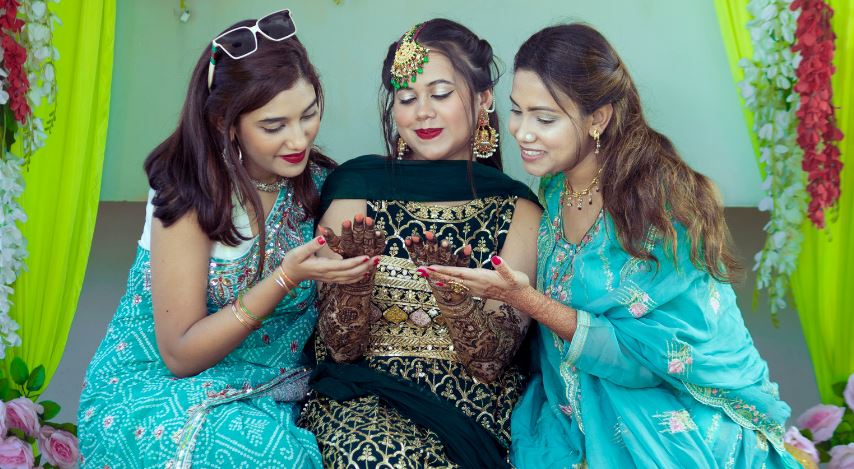Bihar, known for its rich cultural heritage, has a vibrant collection of traditional dresses for women that reflect centuries-old customs and artistry.
From the luxurious silk sarees of Bhagalpur to the artistic Madhubani-painted fabrics, each attire tells a unique story of Bihar’s craftsmanship and traditions.
These garments are not just fashion statements but symbols of cultural pride worn during festivals, weddings, and religious ceremonies.
Whether it’s the elegance of Tussar silk or the vibrant hues of Leheriya sarees, Bihari women’s clothing beautifully blends tradition with modern influences, offering timeless styles cherished across generations.
What Makes Tussar Silk Saree Unique in Bihar’s Traditional Attire?
Tussar silk sarees are considered the pride of Bihar due to their distinctive texture and natural golden sheen. Made from raw silk, these sarees are lightweight and breathable, making them ideal for the region’s climate.
What makes them truly unique is the intricate handwoven designs, often featuring natural motifs like leaves, flowers, and tribal art.
Each saree reflects the region’s artisanal expertise, with Tussar silk primarily woven in Bhagalpur and nearby regions. These sarees are worn during auspicious occasions such as weddings, religious ceremonies, and festivals.
The durability and elegance of Tussar silk have also made it a popular choice in contemporary fashion, blending tradition with modern designs.
Why Are Bhagalpuri Silk Sarees Popular in Indian Weddings?
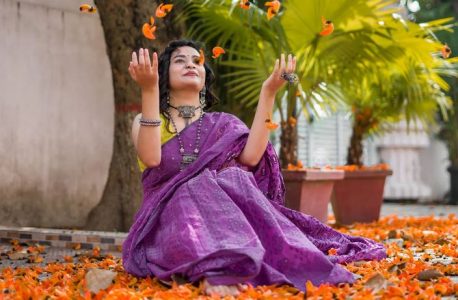
Bhagalpuri silk sarees, known for their luxurious texture and intricate designs, are a popular choice for Indian weddings, particularly in Bihar.
These sarees are woven from the finest silk in Bhagalpur, a town renowned for its centuries-old silk weaving tradition.
The rich, smooth fabric of Bhagalpuri silk drapes elegantly, making it suitable for formal occasions like weddings. Often embellished with natural motifs and zari borders, these sarees exude a timeless beauty.
Bhagalpuri silk is not only traditional but also eco-friendly, as the silk is often organic. Brides and wedding guests wear these sarees, pairing them with heavy jewellery to complete the royal look for one of life’s most significant celebrations.
What Are the Significance and Designs of Madhubani Painting Sarees?
Madhubani painting sarees represent the artistic brilliance of Bihar, combining traditional hand-painted designs with wearable fashion.
These sarees are adorned with intricate motifs from the Madhubani art form, which includes themes from mythology, nature, and village life.
Each saree is unique, hand-painted using natural dyes, giving it a vibrant and colorful appearance. The art form, rooted in Bihar’s Mithila region, reflects the deep cultural heritage of the state.
Madhubani sarees are particularly worn during cultural events, festivals, and religious ceremonies like Chhath Puja. The fusion of art and clothing makes these sarees more than just attire—they are a symbol of Bihar’s rich artistic traditions.
What Is the Cultural Importance of Leheriya Sarees in Bihar?
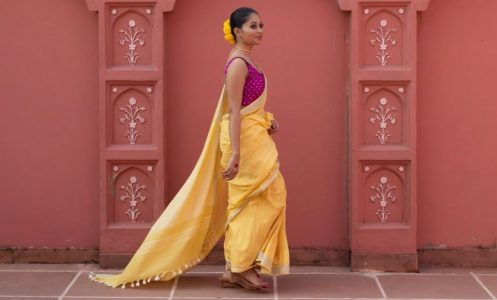
Leheriya sarees, with their wave-like patterns, bring a burst of colour and vibrancy to Bihar’s traditional attire, especially during festivals. Though they originated in Rajasthan, Leheriya sarees have been adopted widely in northern Bihar for celebratory occasions such as Holi, Teej, and Diwali.
These sarees are made using a tie-and-dye technique that creates diagonal stripes in bold, contrasting colours. Lightweight and breathable, they are perfect for the warm climate of Bihar and allow women to move comfortably during long festivities.
Paired with simple jewellery, Leheriya sarees symbolize joy, colour, and the cultural unity seen in Bihari festivals.
How Does Bridal Wear in Bihar Reflect Tradition and Opulence?
Bihari bridal wear is a perfect blend of tradition and opulence, symbolizing prosperity and marital bliss. Brides in Bihar typically wear rich silk sarees or lehengas adorned with heavy embroidery, zari, and sequins.
The colors red, maroon, and gold dominate, representing auspiciousness in Hindu culture. Bridal sarees or lehengas are often paired with elaborate gold jewellery, including necklaces, bangles, and maang tikka, completing the royal wedding look.
The garments are not only designed to be visually stunning but also carry cultural significance passed down through generations. Even modern brides embrace this traditional style, ensuring its continuation in contemporary wedding fashion.
Top 10 Bihar Traditional Dress Female
1. Tussar Silk Saree: The Pride of Bihar
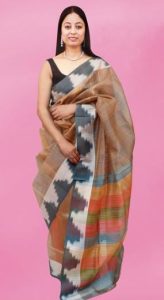
Image – Source
The Tussar silk saree is one of the most iconic traditional garments in Bihar. Known for its rich texture and natural sheen, this saree is crafted from raw silk and holds a significant place in the cultural fabric of Eastern India.
Tussar silk sarees are often worn during religious and festive occasions, and their earthy, subtle shades paired with intricate motifs make them a staple for women in Bihar.
The intricate patterns of leaves, flowers, and tribal designs on Tussar silk sarees add a unique charm. These sarees are handwoven by skilled artisans, ensuring high durability and elegance.
Women often pair them with traditional gold or silver jewellery to complete their look for weddings, festivals, or formal events.
Tussar Silk Saree Features
| Attribute | Details |
| Dress Name | Tussar Silk Saree (for women), Tussar Dhoti (for men) |
| Cultural Essence | Embodies the essence of Eastern Indian tradition, commonly worn by women in states like Bihar, Jharkhand, and West Bengal. |
| Fabric & Material | Made from raw silk, characterized by its rich texture and natural golden sheen, known for its toughness and breathability. |
| Notable Design Features | Features natural motifs like leaves, flowers, and tribal art, often accentuated with zari or embroidered borders. |
| Draping Method | Usually draped in a graceful, flowing manner, with pleats at the front, and the pallu elegantly draped over the shoulder. |
| Occasion Wear | Worn during weddings, religious ceremonies, and festivals like Durga Puja, as well as formal and semi-formal events. |
| Traditional Adornments | Complemented with gold or silver jewellery, matching bangles, traditional nose rings, and men pair it with a traditional kurta. |
| Historical Background | Originates from the tribal regions of Jharkhand and Bihar, where it has been woven for centuries, showcasing artisanal expertise. |
| Regional Influences | Different patterns and weaving styles are found in regions like Bhagalpur and Malda, each with its unique flair and regional identity. |
| Typical Colour Palette | Known for earthy shades such as beige, cream, honey, with contrasting shades like maroon, gold, and green often added for accents. |
| Modern Trends | Contemporary designers experiment with modern cuts, adding sleek blouses and fusing traditional patterns with modern aesthetics. |
| Weaving Techniques | Handwoven by skilled artisans using traditional methods that have been passed down through generations, often involving intricate detailing. |
| Functionality & Comfort | Light yet strong, it is breathable and airy, making it suitable for both summer and winter wear, providing all-day comfort. |
| Symbolic Value | Represents purity, elegance, and grace, often worn by brides and women during auspicious occasions in Indian culture. |
| Festive Importance | Central to grand celebrations such as weddings, pujas, and cultural festivities, showcasing a connection to heritage and opulence. |
| Accessibility & Cost | Widely available in a variety of price ranges, from affordable everyday wear to luxurious designer pieces, especially in urban markets. |
2. Bhagalpuri Silk Saree: Elegance in Weaving
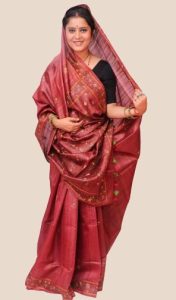
Image – Source
Bhagalpuri silk sarees hail from the town of Bhagalpur in Bihar, a place renowned for its exceptional weaving tradition.
These sarees are made from high-quality silk, offering a luxurious yet comfortable fabric that is highly sought after by Bihari women. The distinctive sheen and softness of Bhagalpuri silk make it perfect for both festive and everyday wear.
Bhagalpuri sarees feature intricate motifs, often inspired by nature, such as flowers, birds, and tribal patterns. These sarees are not only culturally significant but also eco-friendly, as they are crafted from organic silk. Women wear these sarees at weddings, formal events, and celebrations, often pairing them with gold jewellery.
Bhagalpuri Silk Saree Features
| Attribute | Details |
| Dress Name | Bhagalpuri Silk Saree (for women), Bhagalpuri Dhoti (for men) |
| Cultural Essence | Symbolizes the rich weaving tradition of Bhagalpur, a town in Bihar known for its silk production. |
| Fabric & Material | Made from organic silk, known for its smooth texture and glossy appearance. |
| Notable Design Features | Features natural motifs such as flowers, birds, and abstract designs, often embellished with zari or metallic threads. |
| Draping Method | Draped elegantly with pleats in the front and a flowing pallu. |
| Occasion Wear | Suitable for weddings, cultural events, and formal gatherings. |
| Traditional Adornments | Worn with traditional gold or silver jewellery, including heavy necklaces, earrings, and bangles. |
| Historical Background | Bhagalpuri silk weaving dates back to ancient times and is considered a cornerstone of Bihari textile heritage. |
| Regional Influences | Strongly influenced by the natural beauty of Bhagalpur’s surroundings, reflected in the designs and patterns woven into the fabric. |
| Typical Colour Palette | Ranges from soft pastels like beige and cream to vibrant shades such as red, blue, and purple. |
| Modern Trends | Modern versions include fusion designs, often combining traditional weaves with contemporary patterns and cuts. |
| Weaving Techniques | Handwoven by expert artisans, using techniques passed down over generations, ensuring a unique texture and durability. |
| Functionality & Comfort | Lightweight and airy, it’s perfect for both summer and winter use, providing comfort throughout the day. |
| Symbolic Value | A symbol of tradition, luxury, and craftsmanship, representing Bihar’s historical weaving legacy. |
| Festive Importance | Widely worn during weddings, religious functions, and cultural festivities, often a family heirloom passed down through generations. |
| Accessibility & Cost | Available in various price ranges, from affordable to premium, depending on the intricacy of the weave and the quality of the silk. |
3. Madhubani Painting Sarees: Art on Fabric
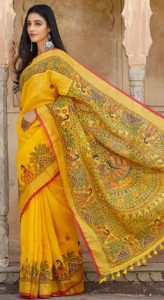
Image – Source
Madhubani painting sarees represent one of the most exquisite forms of Bihar’s artistic heritage. These sarees are crafted by hand, featuring detailed paintings inspired by the famous Madhubani art of Bihar.
The sarees are often adorned with intricate motifs, such as mythological scenes, nature, and daily village life. Each saree is a unique work of art, hand-painted with natural dyes, making it a highly coveted piece among women for cultural events and festivals.
These sarees are not only a fashion statement but also a representation of Bihar’s artistic identity. Popular during festivals like Chhath Puja and Holi, Madhubani sarees are paired with traditional jewellery.
Their vibrant colours and meticulous craftsmanship make them a favourite choice for women who wish to showcase both style and cultural pride.
Madhubani Painting Saree Features
| Attribute | Details |
| Dress Name | Madhubani Painting Saree |
| Cultural Essence | Reflects the rich artistic tradition of Bihar, with roots in the ancient Madhubani painting style. |
| Fabric & Material | Typically made from cotton or silk, hand-painted with natural dyes and intricate Madhubani motifs. |
| Notable Design Features | Showcases intricate scenes from mythology, nature, and folklore, hand-painted by skilled artisans. |
| Draping Method | Draped in a traditional style, allowing the artwork to be prominently displayed on the pallu and borders. |
| Occasion Wear | Ideal for festivals, cultural gatherings, and formal occasions. |
| Traditional Adornments | Paired with traditional jewellery, including bangles, necklaces, and earrings to complement the vibrant artwork. |
| Historical Background | Originates from the Mithila region of Bihar, where Madhubani art has been practiced for centuries, passed down through generations. |
| Regional Influences | Strongly influenced by the Mithila region’s culture and mythology, with regional variations in designs and themes. |
| Typical Colour Palette | Vibrant hues such as red, blue, yellow, and green dominate, often contrasted with neutral shades like white or black. |
| Modern Trends | Modern versions incorporate lighter fabrics and more minimalist designs, blending traditional art with contemporary fashion. |
| Weaving Techniques | Hand-painted using natural dyes, requiring immense skill and precision by artisans who specialize in Madhubani art. |
| Functionality & Comfort | Lightweight and comfortable, especially when made with cotton, suitable for both everyday wear and special occasions. |
| Symbolic Value | Represents the fusion of art and fashion, symbolizing Bihar’s rich cultural heritage and the importance of art in daily life. |
| Festive Importance | Worn during major festivals like Chhath Puja, Holi, and cultural ceremonies, celebrating tradition through wearable art. |
| Accessibility & Cost | Available in a range of prices depending on the intricacy of the painting and the fabric used, from affordable to premium designer pieces. |
4. Khara Dupatta: Festive Dupattas of Bihar
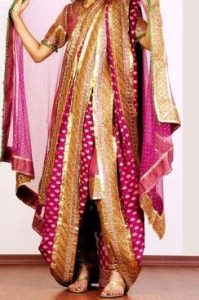
Image – Source
The Khara Dupatta is an essential accessory in the traditional attire of Bihari women, especially during festivals and religious ceremonies. Made from silk or cotton, Khara dupattas are often embellished with zari work, sequins, and intricate embroidery, giving them a regal appearance. Women usually drape the dupatta over their sarees or lehengas, adding an extra layer of elegance to their attire.
This festive garment is known for its vibrant colours and beautiful designs, making it perfect for weddings, pujas, and special occasions.
Whether paired with sarees or kurtis, the Khara Dupatta enhances the overall look with its intricate craftsmanship and bold patterns.
Khara Dupatta Features
| Attribute | Details |
| Dress Name | Khara Dupatta |
| Cultural Essence | Embodies festivity and elegance, commonly worn by women during weddings and religious events in Bihar. |
| Fabric & Material | Made from silk, cotton, or organza, often embellished with zari, sequins, and intricate embroidery. |
| Notable Design Features | Features bold patterns, vibrant colours, and metallic accents that add to the festive spirit of the garment. |
| Draping Method | Draped over the shoulder or across the chest, often in a flowing, graceful style that complements sarees or lehengas. |
| Occasion Wear | Worn during weddings, festivals like Diwali and Durga Puja, and religious ceremonies. |
| Traditional Adornments | Paired with traditional jewellery, including earrings, bangles, and necklaces, to enhance the festive look. |
| Historical Background | Woven in Bihar and other northern regions of India, the Khara Dupatta has been a staple in festive attire for centuries. |
| Regional Influences | Strongly influenced by the vibrant festivals and cultural traditions of Bihar, reflected in the dupatta’s design and embellishments. |
| Typical Colour Palette | Bright, bold colours such as red, gold, orange, and green dominate, often contrasted with metallic zari work. |
| Modern Trends | Modern designers have adapted the Khara Dupatta with minimalist patterns and lighter fabrics, making it versatile for both traditional and contemporary wear. |
| Weaving Techniques | Handwoven or machine-made, depending on the complexity of the design, often involving zari or embroidery techniques. |
| Functionality & Comfort | Lightweight yet luxurious, it’s comfortable to wear and adds a festive touch without overwhelming the overall outfit. |
| Symbolic Value | Symbolizes festivity, tradition, and elegance, often considered an essential accessory in a Bihari woman’s wardrobe during celebrations. |
| Festive Importance | Worn during grand occasions like weddings and pujas, enhancing the overall festive appearance of traditional attire. |
| Accessibility & Cost | Available at various price points, from affordable dupattas to more elaborate, expensive versions adorned with heavy embroidery and intricate zari work. |
5. Sonepuri Sarees: The Golden Tradition
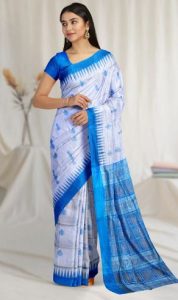
Image – Source
Sonepuri sarees, also known as Sonepur silk sarees, are famous for their elegant golden hue and intricate weaving patterns. These sarees are crafted from high-quality silk and feature detailed motifs inspired by nature and tribal art.
Women in Bihar often choose Sonepuri sarees for significant cultural and religious events, as their luxurious texture and golden sheen make them a perfect choice for weddings and festivals.
The uniqueness of Sonepuri sarees lies in their elaborate designs and the high level of craftsmanship involved in their creation. Worn by brides and women during important celebrations, these sarees are paired with heavy jewellery to enhance the regal look.
Sonepuri Saree Features
| Attribute | Details |
| Dress Name | Sonepuri Saree |
| Cultural Essence | Embodies the luxurious traditions of Bihar, commonly worn during weddings and grand celebrations. |
| Fabric & Material | Made from high-quality silk with a golden sheen, often accentuated with zari work and detailed motifs. |
| Notable Design Features | Features intricate patterns inspired by nature and tribal art, with a focus on rich golden hues and fine weaving. |
| Draping Method | Draped in a traditional style, with pleats in the front and the pallu gracefully draped over the shoulder. |
| Occasion Wear | Worn during weddings, cultural events, and major religious festivals. |
| Traditional Adornments | Paired with heavy traditional jewellery, including gold necklaces, earrings, and bangles, adding to the opulent appearance. |
| Historical Background | Has a rich weaving tradition dating back to ancient times, particularly in the Sonepur region of Bihar. |
| Regional Influences | Strongly influenced by the local culture and heritage of Sonepur, with unique patterns and colours that reflect regional identity. |
| Typical Colour Palette | Predominantly golden shades, with accents of red, green, and maroon to enhance the richness of the fabric. |
| Modern Trends | Contemporary designers are experimenting with lighter fabrics and fusion patterns, combining traditional motifs with modern aesthetics. |
| Weaving Techniques | Handwoven using fine silk threads, often requiring months of skilled craftsmanship to produce intricate designs. |
| Functionality & Comfort | Light and breathable, yet luxurious, making it ideal for both formal and ceremonial wear, especially in warm climates. |
| Symbolic Value | Represents wealth, opulence, and tradition, especially during weddings and festive occasions. |
| Festive Importance | Central to wedding attire and other major cultural festivals in Bihar, often considered a family heirloom passed down through generations. |
| Accessibility & Cost | Available in various price ranges, from moderately priced sarees to premium pieces, depending on the intricacy of the design and the quality of the silk. |
6. Leheriya Saree: A Riot of Colours
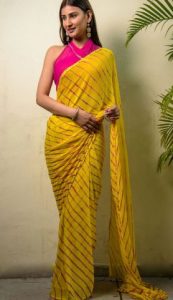
Image – Source
Leheriya sarees are vibrant and colourful, known for their wave-like patterns that are created using traditional dyeing techniques. Originating from Rajasthan, these sarees have gained popularity in northern Bihar for festivals and special occasions.
The bright, contrasting hues of Leheriya sarees make them a striking addition to any woman’s wardrobe. Typically made from lightweight fabrics like cotton or silk, these sarees are ideal for the warm climate and are comfortable for day-long wear.
In Bihar, women wear Leheriya sarees during festivals such as Teej and Holi. The saree’s unique design is created through a tie-and-dye method, resulting in bold diagonal stripes across the fabric. Paired with traditional silver jewellery or gold ornaments, Leheriya sarees bring a festive touch to any occasion.
Leheriya Saree Features
| Attribute | Details |
| Dress Name | Leheriya Saree |
| Cultural Essence | A reflection of vibrant festival culture, worn widely during celebrations in northern Bihar and Rajasthan. |
| Fabric & Material | Made from cotton or silk, known for its breathable quality and light texture. |
| Notable Design Features | Features diagonal stripes in bright, contrasting colours, created using traditional tie-and-dye techniques. |
| Draping Method | Draped traditionally, allowing the wave-like patterns to stand out, with the pallu elegantly placed over the shoulder. |
| Occasion Wear | Popular during festivals like Holi, Teej, and other cultural events. |
| Traditional Adornments | Paired with silver or gold jewellery, especially oxidized earrings, bangles, and anklets, enhancing the ethnic look. |
| Historical Background | Originated from Rajasthan but has become a beloved part of northern Bihar’s festival attire, blending two regional traditions. |
| Regional Influences | Strongly influenced by Rajasthani tie-dye techniques but adapted to suit Bihari festivals and celebrations. |
| Typical Colour Palette | Bright, contrasting colours such as red, yellow, pink, and blue are predominant, giving the saree a festive and cheerful appearance. |
| Modern Trends | Designers incorporate more muted tones and modern cuts, making Leheriya sarees suitable for both casual and formal occasions. |
| Weaving Techniques | Hand-dyed using traditional tie-and-dye techniques, resulting in unique and bold wave patterns across the fabric. |
| Functionality & Comfort | Lightweight and breathable, perfect for hot climates and long festivities, ensuring both comfort and style. |
| Symbolic Value | Symbolizes joy, festivity, and cultural unity, especially during Holi and other colourful festivals in Bihar. |
| Festive Importance | Central to celebrations like Teej and Holi, where colour and vibrancy play a vital role in the festivities. |
| Accessibility & Cost | Available at affordable prices for everyday wear, with premium options available for festivals and special events. |
7. Cotton Sarees: The Everyday Attire
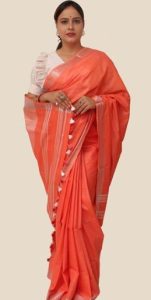
Image – Source
Cotton sarees are an integral part of everyday life for women in Bihar. These sarees are lightweight, breathable, and perfect for the region’s hot and humid climate.
Simple yet elegant, cotton sarees come in various colours and patterns, making them versatile for daily wear as well as informal gatherings.
Women often prefer cotton sarees for their comfort, especially during summer months when heavy fabrics become difficult to manage.
The simplicity of cotton sarees doesn’t take away from their beauty. They are available in a wide range of designs, from plain solid colours to more intricate prints like block printing or traditional Bihari patterns.
These sarees can be easily dressed up or down, depending on the occasion, making them a staple in Bihari women’s wardrobes.
Cotton Saree Features
| Attribute | Details |
| Dress Name | Cotton Saree |
| Cultural Essence | A staple in everyday attire, reflecting simplicity and comfort while still maintaining a touch of elegance. |
| Fabric & Material | Made from soft, breathable cotton, ideal for hot climates, especially during the summer season in Bihar. |
| Notable Design Features | Available in a variety of patterns, from plain solid colours to more intricate block prints, allowing for versatility in styling. |
| Draping Method | Draped in a simple and practical manner, often with minimal pleats and a short pallu for convenience during daily activities. |
| Occasion Wear | Primarily worn for everyday use, as well as informal gatherings and casual events. |
| Traditional Adornments | Paired with minimal jewellery, such as silver bangles and small earrings, to keep the look simple yet elegant. |
| Historical Background | Cotton sarees have been worn by women in Bihar for centuries, with traditional handloom techniques being used to produce these sarees. |
| Regional Influences | Strongly influenced by the local climate and lifestyle, resulting in practical, comfortable designs that are ideal for daily wear. |
| Typical Colour Palette | Includes soft pastels, neutrals, and bright colours, often featuring simple patterns or block prints to add a touch of style. |
| Modern Trends | Modern designs incorporate more elaborate patterns, while still maintaining the comfort and simplicity that make cotton sarees a favorite. |
| Weaving Techniques | Handwoven or machine-made, depending on the design and level of intricacy, often using traditional methods passed down through generations. |
| Functionality & Comfort | Lightweight, breathable, and easy to wear, offering all-day comfort and practicality for women in their daily lives. |
| Symbolic Value | Represents simplicity, practicality, and elegance, making it a symbol of the everyday woman in Bihar. |
| Festive Importance | Though primarily worn as casual attire, cotton sarees can also be dressed up for festivals and small family gatherings. |
| Accessibility & Cost | Widely available at affordable prices, with higher-end options available for more intricate designs and handloom varieties. |
8. Bihar Bridal Wear: The Royal Wedding Look
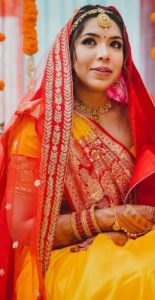
Image – Source
Bihari bridal wear is all about grandeur and tradition, with brides often opting for luxurious silk sarees or lehengas on their big day. These garments are heavily embroidered with zari, sequins, and beads, making them ornate and perfect for the occasion.
The bridal attire in Bihar is designed to showcase opulence, with a deep emphasis on the use of red, maroon, and gold—traditional colours symbolizing prosperity and marital bliss.
A typical Bihari bride completes her look with elaborate gold jewellery, including necklaces, earrings, bangles, and maang tikka. The bridal saree or lehenga is often accompanied by a dupatta draped over the head, symbolizing purity and grace.
Brides in Bihar traditionally wear these rich, embellished garments during their wedding rituals and ceremonies, making it a central part of the cultural wedding customs.
Bihar Bridal Wear Features
| Attribute | Details |
| Dress Name | Bihar Bridal Saree or Lehenga |
| Cultural Essence | Symbolizes the grandeur and opulence of traditional Bihari weddings, with heavy embroidery and rich fabrics. |
| Fabric & Material | Made from luxurious silk, often embellished with zari, sequins, and intricate beadwork to create an ornate, regal look. |
| Notable Design Features | Features elaborate embroidery, often in gold or silver, with rich colours such as red, maroon, and gold dominating the bridal palette. |
| Draping Method | Draped in a traditional style, with the dupatta placed over the head during wedding rituals, adding to the bride’s grace and elegance. |
| Occasion Wear | Exclusively worn during wedding ceremonies and important pre-wedding rituals, such as the mehendi and sangeet functions. |
| Traditional Adornments | Complemented by heavy gold jewellery, including necklaces, earrings, bangles, and maang tikka, adding to the bride’s regal appearance. |
| Historical Background | Bridal wear has deep roots in Bihari wedding customs, with brides traditionally wearing red or maroon sarees or lehengas for their nuptials. |
| Regional Influences | Strongly influenced by the rich cultural traditions of Bihar, with a blend of regional styles and modern fashion in contemporary bridal designs. |
| Typical Colour Palette | Dominated by red, maroon, and gold, symbolizing prosperity, happiness, and purity in Bihari weddings. |
| Modern Trends | Modern brides are experimenting with lighter fabrics and pastel colours, while still maintaining the traditional Bihari bridal elements. |
| Weaving Techniques | Handwoven or machine-made, depending on the complexity of the design, with elaborate detailing that showcases fine craftsmanship. |
| Functionality & Comfort | Though often heavy and ornate, modern bridal wear incorporates lighter fabrics for ease of movement during long wedding ceremonies. |
| Symbolic Value | Represents marital bliss, prosperity, and tradition, with the colour red symbolizing good fortune and love in Hindu wedding customs. |
| Festive Importance | Central to the wedding ceremony, with the bridal saree or lehenga playing a pivotal role in the overall aesthetic and significance of the wedding rituals. |
| Accessibility & Cost | Available in a wide range of prices, from affordable to high-end designer bridal wear, depending on the fabric, embroidery, and overall design. |
9. Angavastram: Draping Tradition
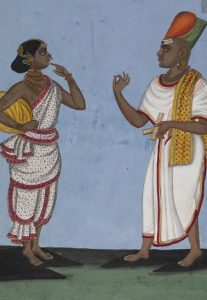
Image – Source
Angavastram is a traditional garment that holds a significant place in the cultural attire of both men and women in Bihar. While it is more commonly worn by men, women also wear the Angavastram during important religious and ceremonial occasions.
This garment is essentially a long piece of cloth, draped over the shoulder and wrapped around the body, symbolizing purity and simplicity. For women, it is often paired with a saree or lehenga for a complete traditional look.
The Angavastram is usually made from fine cotton or silk, depending on the occasion. While it is plain in design, its simplicity is what makes it elegant, especially when paired with gold or silver jewellery. The garment is particularly worn during pujas, weddings, and other cultural events, symbolizing devotion and respect in Bihari society.
Angavastram Features
| Attribute | Details |
| Dress Name | Angavastram |
| Cultural Essence | Represents simplicity and devotion, commonly worn during religious and ceremonial occasions by both men and women. |
| Fabric & Material | Made from fine cotton or silk, depending on the formality of the occasion, often plain or with minimal embellishments. |
| Notable Design Features | Simple in design, usually plain or with subtle borders, allowing the focus to remain on the individual’s spirituality and devotion. |
| Draping Method | Draped over the shoulder and wrapped around the body, often paired with sarees or lehengas for women. |
| Occasion Wear | Primarily worn during religious ceremonies, weddings, and cultural functions, symbolizing purity and respect. |
| Traditional Adornments | Paired with minimal jewellery, such as gold chains or silver anklets, to maintain the simplicity and traditional appeal of the garment. |
| Historical Background | The tradition of wearing Angavastram dates back to ancient India, where it was commonly worn by priests and men of high cultural standing, now adopted by women as well. |
| Regional Influences | Strongly influenced by the religious practices of Bihar, with regional variations in fabric and design based on the occasion. |
| Typical Colour Palette | Predominantly white or cream, symbolizing purity, though variants in red, gold, and green are sometimes used for festive occasions. |
| Modern Trends | Contemporary versions feature minimalistic patterns or modern cuts, blending traditional draping methods with modern aesthetics. |
| Weaving Techniques | Handwoven using traditional techniques, ensuring that the fabric remains light and breathable, especially in warm climates. |
| Functionality & Comfort | Light, simple, and easy to drape, providing all-day comfort during religious or ceremonial functions. |
| Symbolic Value | Represents purity, humility, and spiritual devotion, making it a key part of Bihari cultural and religious attire. |
| Festive Importance | Often worn during important ceremonies such as weddings, pujas, and cultural festivals, symbolizing the individual’s connection to tradition and spirituality. |
| Accessibility & Cost | Easily available in a wide range of prices, from affordable cotton options to more premium silk versions for formal occasions. |
10. Traditional Lehenga Choli: Modern Touch with Tradition
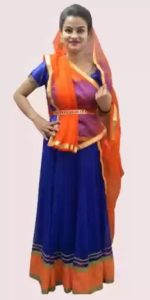
Image – Source
The traditional lehenga choli has long been a popular festive and bridal outfit in Bihar. This attire consists of a long, flowing skirt (lehenga), a fitted blouse (choli), and a dupatta, making it a versatile and stunning option for weddings and cultural festivals.
In Bihar, lehengas are often richly embroidered with zari, beads, and sequins, making them ornate and perfect for brides or women attending special occasions. While the lehenga choli is widely worn across India, it carries unique Bihari influences, with a focus on traditional motifs and vibrant colours.
The Bihari lehenga choli is commonly seen during weddings, especially among brides who want a blend of modern and traditional fashion. Heavy silk or velvet fabrics are used, paired with rich embroidery and elaborate designs.
Today, designers have introduced contemporary styles that fuse traditional embroidery with modern cuts, making this outfit a fashionable choice for young women as well.
Traditional Lehenga Choli Features
| Attribute | Details |
| Dress Name | Traditional Lehenga Choli |
| Cultural Essence | Combines tradition with modern fashion, making it a popular choice for weddings and festive events in Bihar. |
| Fabric & Material | Made from rich fabrics like silk, velvet, or georgette, often adorned with intricate embroidery, zari work, or sequins. |
| Notable Design Features | Features a long, flowing skirt, a fitted blouse, and a dupatta, with heavy embellishments like beads, sequins, and zari for a luxurious finish. |
| Draping Method | Draped in a variety of ways, with the dupatta placed over the shoulder or around the head for traditional occasions like weddings. |
| Occasion Wear | Primarily worn during weddings, engagement ceremonies, and important festivals like Diwali and Durga Puja. |
| Traditional Adornments | Paired with heavy gold or silver jewellery, including necklaces, earrings, bangles, and anklets, to enhance the regal look. |
| Historical Background | The lehenga choli has deep roots in Indian culture, evolving over centuries, and remains a popular outfit for brides and young women in Bihar. |
| Regional Influences | Strongly influenced by northern and eastern Indian fashion, with a focus on heavy embroidery and bold colours typical of Bihari traditions. |
| Typical Colour Palette | Vibrant hues such as red, pink, maroon, and gold dominate, with modern versions incorporating pastels and metallics for a contemporary look. |
| Modern Trends | Contemporary lehengas feature fusion designs, such as modern cuts and lighter fabrics, while still retaining traditional embroidery and embellishments. |
| Weaving Techniques | Made using both handwoven and machine-made techniques, depending on the intricacy of the design and the fabric. |
| Functionality & Comfort | Though heavy and ornate, modern lehengas are designed to be more lightweight and comfortable, ensuring ease of movement during long ceremonies. |
| Symbolic Value | Represents elegance, tradition, and beauty, making it a symbol of femininity and cultural pride, especially during weddings and festivals. |
| Festive Importance | Central to wedding attire and other grand celebrations, symbolizing wealth, tradition, and festivity through its vibrant colours and ornate design. |
| Accessibility & Cost | Available in a wide range of prices, from budget-friendly options to high-end designer lehengas, depending on the fabric and level of detail in the embroidery. |
Conclusion
Bihar’s traditional dresses for females are a celebration of culture, craftsmanship, and heritage. Each garment, from the artistic Madhubani saree to the grand bridal lehengas, showcases the diversity and richness of Bihar’s fashion.
These attires not only enhance a woman’s beauty but also connect them to their roots, reflecting centuries of tradition and craftsmanship passed down through generations.
As contemporary fashion embraces traditional elements, Bihari dresses continue to inspire with their timeless elegance and cultural significance. Wearing these outfits honours Bihar’s past while bringing its vibrant traditions into the modern world.
FAQs
What Is Special About Tussar Silk Sarees?
Tussar silk sarees are known for their rich texture, natural golden sheen, and intricate handwoven designs, making them a favorite for weddings and festivals in Bihar.
Why Are Bhagalpuri Silk Sarees Preferred for Weddings?
Bhagalpuri silk sarees offer a luxurious drape with rich silk fabric and natural motifs, making them ideal for grand celebrations like weddings.
How Are Madhubani Painting Sarees Made?
Madhubani painting sarees are hand-painted with natural dyes, featuring intricate designs inspired by mythology, nature, and folklore from the Mithila region.
When Are Leheriya Sarees Worn in Bihar?
Leheriya sarees are worn during festivals like Holi and Teej, known for their vibrant wave-like patterns created using traditional tie-dye techniques.
What Do Brides in Bihar Traditionally Wear?
Bihari brides wear rich silk sarees or lehengas, adorned with heavy embroidery and zari work, in traditional colors like red, maroon, and gold.

